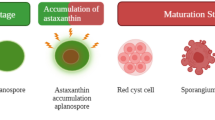Abstract
The phycobiliproteins (PBSs) are large pigment proteins found in certain algae that play a central role in harvesting light energy for photosynthesis. Phycocyanin (PC) is one type of PBSs that gains increasing attention owing to its various biological and pharmacological properties. In this paper, an expression vector containing five essential genes in charge of biosynthesis of cyanobacterial C-phycocyanin (C-PC) holo-α subunit (holo-CpcA) was successfully constructed resulting in over-expression of a fluorescent holo-CpcA in E. coli BL21. The vector harbored two cassettes: one cassette carried genes hox1 and pcyA required for conversion of heme to phycocyanobilin (PCB), and the other cassette carried cpcA encoding CpcA along with cpcE and cpcF both of which were necessary and sufficient for the correct addition of PCB to CpcA. The vector system contained a His-tag for protein purification. The purified protein showed correct molecular weight on SDS-PAGE gel and emitted orange fluorescence by UV excitation. The maximum peak of absorbance spectrum was at 623 nm, and the maximum peak of fluorescence emission and excitation were at 648 and 633 nm, respectively, which were similar to those of native C-PC. This study provides an efficient method for large-scale production of the fluorescent holo-CpcA in biotechnological applications.





Similar content being viewed by others
Abbreviations
- PBS:
-
phycobiliproteins
- CpcA:
-
α subunit of C-phycocyanin
- CpcE and CpcF:
-
subunits of the heterodimeric phycocyanin α-subunit phycocyanobilin lyase
- Hox1:
-
heme oxygenase 1
- HT:
-
His-tag
- PCB:
-
phycocyanobilin
- PcyA:
-
3Z-phycocyanobilin: ferredoxin oxidoreductase
- Sp:
-
spectinomycin
- Km:
-
kanamycin
References
Grossman, A. R., Schaefer, M. R., Chiang, & G. G., Collier, J. L. (1993). The Phycobilisome, a light-harvesting complex responsive to environmental conditions. Microbiological Reviews, 57, 725–749.
Glazer, A. N. (1994). Adaptive variations in Phycobilisome structure. Advances in Molecular and Cellular Biology. 10, 119–149.
Glazer, A. N. (1988). Phycobilisomes. Methods in Enzymology, 167, 291–303.
Sidler, W. A. (1994). Phycobilisome and phycobiliprotein structures. In Bryant D. A. (Ed), The Molecular Biology of Cyanobacteria. Dordrecht, Netherlands: Kluwer Academic Publishers.
Sun, L., Wang, S. M., Chen, L. X., & Gong, X. Q. (2003). Promising fluorescent probes from phycobiliproteins. IEEE Journal of Quantum Electronics, 9, 177–188.
MacColl, R. (1998). Cyanobacterial Phycobilisomes. Journal of Structural Biology, 124, 311–334.
Subhashini, J., Mahipal, S. V., Reddy, M. C., et al. (2004). Molecular mechanisms in C-Phycocyanin induced apoptosis in human chronic myeloid leukemia cell line-K562. Biochemical Pharmacology, 68, 453–462.
Minkova, K. M., Tchernov, A. A., Tchorbadjieva, M. I., et al. (2003). Purification of C-phycocyanin from Spirulina (Arthrospira) fusiformis. Journal of Biotechnology, 102, 55-59.
Patel, A., Mishra, S., Pawar, R., & Ghosh, P. K. (2005). Purification and characterization of C- Phycocyanin from cyanobacterial species of marine and freshwater habitat. Protein Expression and Purification, 40, 248–255.
Bermejo, R., Fernandez, E., Alvarez-Pez, J. M., & Talavera, E. M. (2002). Labeling of cytosine residues with biliproteins for use as fluorescent DNA probes. Journal of Luminescence, 99, 113–124.
Tooley, A. J., Cai, Y. A., & Glazer, A. N. (2001). Biosynthesis of a fluorescent cyanobacterial C-phycocyanin holo-α subunit in a heterologous host. PNAS. 98, 60–65.
Maniatis, T., Fritsch, E. F., & Sambrook, J. (1982). Molecular cloning, A laboratory manual. Cold Spring Harbor, New York: Cold Spring Harbor Laboratory.
Berkelman, T., & Lagarias, J. C. (1986). Visualization of bilin-linked peptides and proteins in polyacrylamide gels. Analytical Biochemistry, 156, 194–201.
Ge, B. S., Tang, Z. H., Zhao, F. Q., et al. (2005). Scale-up of fermentation and purification of recombinant allophycocyanin over-expressed in Escherichia coli. Process Biochemistry, 40, 3190–3195.
Zhao, K. H., Zhu, J. P., Song, B., et al. (2004). Nonenzymatic chromophore attachment in biliproteins: Conformational control by the detergent Triton X-100. BBA. 1657, 131–145.
Acknowledgement
This work was supported by grants from Key Innovative Project of Chinese Academy of Sciences (KZCX-3-SW-215).
Author information
Authors and Affiliations
Corresponding author
Additional information
Guan and Qin contributed equally to this study.
Rights and permissions
About this article
Cite this article
Guan, X., Qin, S., Su, Z. et al. Combinational Biosynthesis of a Fluorescent Cyanobacterial Holo-α-Phycocyanin in Escherichia coli by Using One Expression Vector. Appl Biochem Biotechnol 142, 52–59 (2007). https://doi.org/10.1007/s12010-007-8000-7
Published:
Issue Date:
DOI: https://doi.org/10.1007/s12010-007-8000-7




